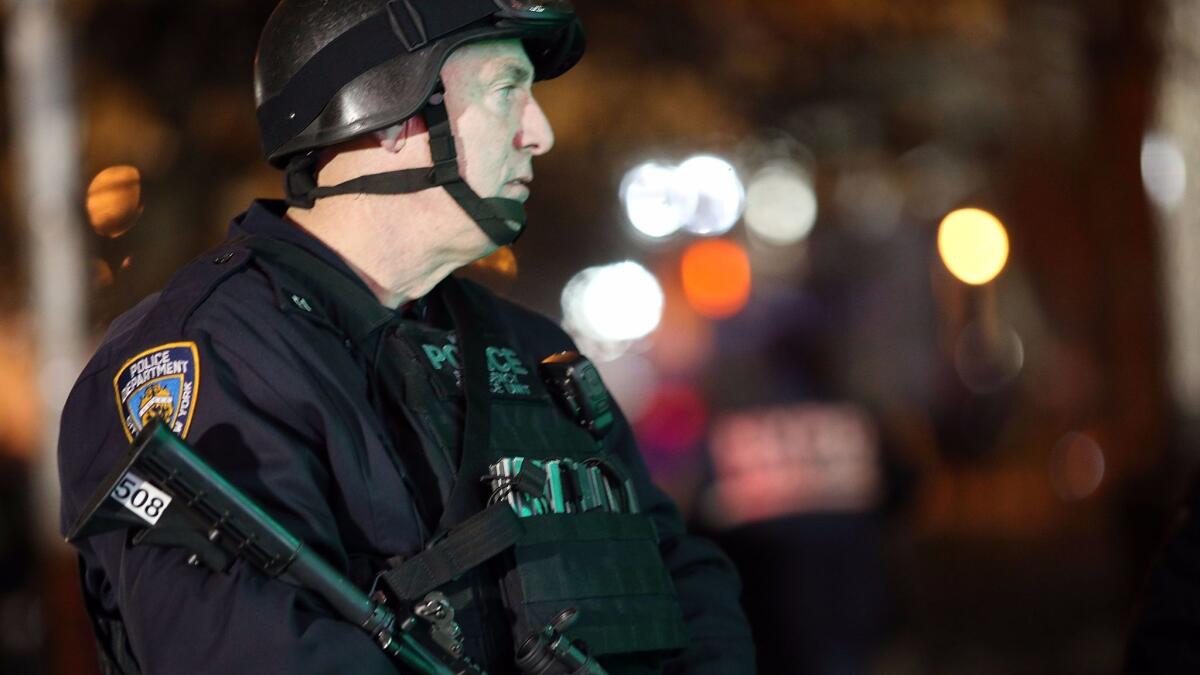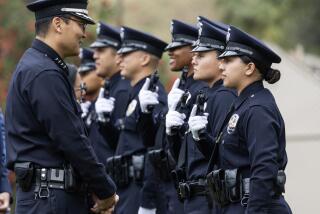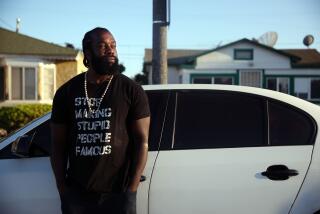In New York, major crime complaints fell when cops took a break from ‘proactive policing’

- Share via
When New York police officers temporarily reduced their “proactive policing” efforts on low-level offenses, major-crime reports in the city actually fell, according to a study based on New York Police Department crime statistics.
The findings, published in the journal Nature Human Behaviour, put a crack in the “broken windows” theory of policing that has become a mainstay of many urban police departments.
“Order maintenance policing,” a type of proactive policing, is informed by the ‘broken windows’ theory — the idea that by fighting smaller crimes, it’s possible to create a ‘lawful’ environment that helps deter the more serious crimes. It’s an idea that was put to use in the 1990s by former New York City Police Commissioner William Bratton (who also served as Los Angeles police chief from 2002 to 2009).
The idea has taken hold in police departments around the U.S. But some researchers have worried that this kind of policing can have a detrimental effect in the communities it targets.
“A serious concern is that proactive policing diverts finite resources and attention away from investigative units, including detectives working to track down serial offenders and break up criminal networks,” the authors point out. “Proactive policing also disrupts communal life, which can drain social control of group-level violence. Citizens are arrested, unauthorized markets are disrupted, and people lose their jobs, all of which create more localized stress on individuals already living on the edge. Such strains are imposed directly through proactive policing, and thus are independent from subsequent judgments of guilt or innocence.”
Either way, these arguments are hard to test, because the cause-and-effect of policing and crime are difficult to tease apart.
“Police officers target their efforts at areas where crime is anticipated and/or where they expect enforcement will be most effective,” they wrote. “Simultaneously, citizens decide to comply with the law or commit crime partly on the basis of police deployment and enforcement strategies. In other words, policing and crime are endogenous to unobservable strategic interaction, which frustrates causal analysis.”
That changed over the course of several weeks in late 2014 and early 2015. After a jury declined to indict the officers involved in the fatal chokehold of Eric Garner in Staten Island, the NYPD held a work “slowdown” for about seven weeks as political conflict between protesters, Mayor Bill de Blasio and the city’s police unions intensified.
Legally, police officers can’t strike. But they can “work-to-rule,” doing only the most necessary duties. They responded to calls only in pairs, left their squad cars only if they felt compelled, and did not perform certain proactive policing tactics, such as getting out of their vehicles to issue summonses or arrest people for petty crimes and misdemeanors. The officers were ultimately ordered to return to work by Jan. 16, 2015.
This sudden slowdown provided researchers an opportunity to answer the question: Did crime rates go up when proactive policing went down?
“This makes for a unique natural experiment to identify the causal effects of changing police practices,” the authors wrote.
The scientists filed Freedom of Information Act requests for a large set of NYPD CompStat reports from 2013 to 2016. These reports describe the weekly activity for each NYPD precinct, including: “Criminal summonses” for penal law violations such as public alcohol consumption and disorderly conduct; “Stop, question and frisks” or SQFs; “Non-major crime arrests,” the vast majority of which are misdemeanors; and “Major crime complaints,” such as murder, rape, robbery and felony assault.
During the slowdown, the researchers found that police dramatically reduced the number of criminal summonses and SQFs — a confirmation that, indeed, the low-level proactive policing activities had gone down. Non-major crime arrests also took a dip. So did narcotics arrests.
So, with the drop in relatively low-level police activity, what happened to serious crime in the city? The scientists found that civilian complaints of major crimes dropped by about 3% to 6% during the slowdown.
“The cessation of proactive policing corresponds roughly to the relative decline in crime that earlier research attributed to the effects of mass incarceration,” the authors noted.
The researchers ran the analysis under a couple other models, and the results still held. They examined whether crime underreporting could have biased the findings, and the results still held.
“While we cannot entirely rule out the effects of under-reporting,” the authors wrote, “our results show that crime complaints decreased, rather than increased, during a slowdown in proactive policing, contrary to deterrence theory.”
Each week during the slowdown saw civilians report an estimated 43 fewer felony assaults, 40 fewer burglaries and 40 fewer acts of grand larceny. And this slight suppression of major crime rates actually continued for seven to 14 weeks after those drops in proactive policing — which led the researchers to estimate that overall, the slowdown resulted in about 2,100 fewer major-crimes complaints.
The broken windows theory posits that fighting smaller crimes helps to prevent the larger ones. But in this case, it seems that the opposite may have been true.
“In their efforts to increase civilian compliance, certain policing tactics may inadvertently contribute to serious criminal activity,” the researchers wrote. “The implications for understanding policing in a democratic society should not be understated.”
The findings show that experts may need to reconsider their assumptions about what is and isn’t effective in law enforcement practices, the authors said.
“Our results imply not only that these tactics fail at their stated objective of reducing major legal violations, but also that the initial deployment of proactive policing can inspire additional crimes that later provide justification for further increasing police stops, summonses and so on,” the authors wrote.
The researchers also noted that proactive policing is often used disproportionately in communities with high poverty rates and large numbers of people of color.
“The vicious feedback between proactive policing and major crime can exacerbate political and economic inequality across communities,” they said. “In the absence of reliable evidence of the effectiveness of proactive policing, it is time to consider how proactive policing reform might reduce crime and increase well-being in the most heavily policed communities.”
In a commentary, David Weisburd of George Mason University pointed out that the study’s conclusions should be limited to a specific subset of proactive policing tactics.
“Certainly, this evidence should not be generalized across the broad array of proactive policing strategies,” said Weisburd, who was not involved in the paper. “It is limited to a very specific approach applied very broadly in a large urban area.
“But at the same time, as the authors note, they have capitalized on an interesting natural experiment that allows them to overcome the causal limitations of previous non-experimental work,” he added. “This is well-done social science, and in this context the results have strong weight.”
Still, he added, this isn’t a randomized experiment, and so the results aren’t entirely clear. Not every potential unknown could be nailed down in a “natural experiment” such as this. For example, even during the slowdown, did the police continue their practice of identifying and focusing on crime hot spots?
“My point is simply that we don’t know what the shock actually tells us because we don’t have a detailed understanding of what the police were doing,” Weisburd wrote. “This gap suggests that we need experimental evidence of the impacts of proactivity at the jurisdictional level. Non-experimental studies simply cannot overcome the myriad threats to the causal interpretation of the findings.”
Setting up large-scale policing experiments is a difficult and expensive operation, he said — but it’s increasingly looking like a necessary step to understand which practices really makes cities safer.
“The first law of treatment is ‘do no harm’,” Weisburd wrote. “[The authors] suggest that generalized enforcement of low-level offenses does just that. We have a moral imperative to carry out well-designed experimental studies that can give us unambiguous answers to this important policy question.”
Follow @aminawrite on Twitter for more science news and “like” Los Angeles Times Science & Health on Facebook.
MORE IN SCIENCE
Mosquitoes spread deadly diseases, and public health experts hope to fight back with this new emoji
Plant-eating dinosaurs may have dined on crustaceans on special occasions, study says
Pediatricians may view tattoos, piercings as red flags. They should discuss it instead, report says







